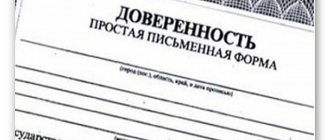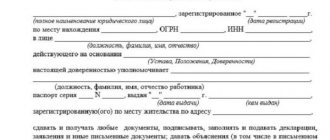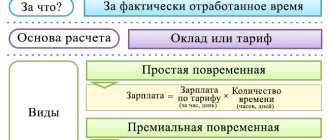What is the transfer procedure?
There is no legal concept of subrogation. However, all the basic characteristics established by the science of civil law will help to obtain a suitable definition.
Reliability is distinguished by the following characteristics:
- This is a one-sided deal. It is performed by the original attorney in order to provide more effective representation of the interests of the principal.
- The form that a power of attorney issued by substitution must comply with must be drawn up in accordance with the requirements established by law.
- This document is completely derived from the original power of attorney. The powers under it cannot be expanded. In addition, the validity period of such a power of attorney cannot extend beyond the time limits of the main document.
Considering these characteristics, a subpoena can be defined as a unilateral transaction made by the original attorney to transfer powers under a power of attorney, the form of which must comply with the requirements of the law, and the content and term cannot go beyond such parameters established in the original document.
Cancellation of this power of attorney is possible both together with the main one and separately from it.
Accompanying a lawyer during the transfer procedure
Help from a specialist with 20 years of experience!
+7
Terms in a power of attorney with substitution
There's nothing new here. The rules regarding deadlines are the same as for simple powers of attorney. In other words, the grantor himself determines how long the trust document will be valid. Today there are no restrictions here. A power of attorney can be issued for one day or one hundred years. Of course, the principal assesses the real situation, so he knows approximately how long the document should be valid.
If desired, the principal, without specifying any reasons, has the right to early cancel the document. If a representative delegates his powers to a third party, such delegation is also canceled automatically. When drawing up a sub-power of attorney, you need to remember that the validity period of the second power of attorney cannot exceed the validity period of the main document. After the main document loses its legal force, for example, after expiration, the representative will no longer be able to issue a subassignment.
Procedure for drawing up the document
Many powers of attorney that are drawn up on behalf of a legal entity do not require a notary signature. Usually the document is certified by the company seal and signature of the director. But this applies exclusively to documents that do not give the right to draw up a transfer of power.
If the document is drawn up taking into account that the representative will draw up the power of attorney for someone else, you will need to contact a notary office. This is explained quite simply. You need to understand that the principal is responsible for all actions performed by the representative under a power of attorney. And if an attorney decides to issue a sub-power of attorney, this can cause serious problems for the party who writes the power of attorney. A visit to a notary’s office is necessary so that the lawyer can clearly explain to the principal what risks a power of attorney with the right of substitution carries. In fact, notarization can be called additional insurance.
When signing a document with the right of subrogation, the notary makes a corresponding note in the register. This indicates that information about this document is officially registered. Naturally, in this case the principal will not be able to make any claims to his representatives.
Do not forget that the execution of a transfer of power must be accompanied by notification to the principal. He should be informed about this as early as possible. Lawyers recommend doing this using Russian Post. You need to order a notice with notification. This way, the trustee will have in hand documentary evidence that he notified the principal that he was going to issue a transfer of trust. The notification must contain information from a third party, who will also act under a second power of attorney. You need to understand that if this notice is not sent, responsibility for the actions of the third party falls on the first representative.
Types of powers of attorney executed in the order of substitution
There are several classifications of such documents. Depending on how many times such actions were performed, they are distinguished:
- initial reassignment, which is the 2nd link in the chain of relevant documents;
- subsequent transfer of trust, serving as the 3rd and further link in this chain.
Depending on what form is used, there are:
- simple written power of attorney;
- power of attorney that has been notarized.
Depending on the possibility of cancellation:
- standard power of attorney;
- irrevocable power of attorney.
Rules for drawing up and processing a document
The document does not have a unified template that is mandatory for use, therefore it is written in any form, depending on the idea of this document and the needs of the principal. However, there is a number of information that must be contained in it without fail, these are the following data:
- about the principal and the authorized person,
- a complete list of actions that a trusted person can perform on behalf of his principal,
- the period during which it is valid,
- place and time of its compilation.
In addition, this power of attorney must contain information about its certification by a notary:
- surname, name, patronymic of the notary,
- the name of the notary office where the certification took place,
- document registration number.
The power of attorney can be issued either on a regular standard A4 sheet or on the organization’s letterhead; it can be written either “manually” or printed on a computer, but it must certainly contain “live” signatures of the interested parties.
Grounds for which it is possible to delegate powers
The main reason is the indication of such a possibility in the original document. A power of attorney with the right of substitution must have an extremely clear formulation of this power. As a rule, we are talking about the phrase “the powers under this power of attorney can be transferred to other persons.”
The other reason is exceptional. This is understood as the effect of circumstances forcing the original trustee to make a transfer of trust. These may include a serious illness or injury that limits the ability of this person, as well as various types of natural disasters, wars and states of emergency.
The main criterion is the significant difficulties of the original attorney in defending the interests of the one who issued the document. Such grounds are not subject to application if, at the request of the trustee, a corresponding prohibition is expressly established.
Power of attorney structure
We offer our users the opportunity to download a standard and fully functional template of a power of attorney from a legal entity to a legal entity. You will need to enter the following information in the template lines to be filled out:
- date of issue of the power of attorney;
- registration number of the power of attorney;
- information about the principal (legal status, details);
- limits of authority;
- validity period of the power of attorney;
- right or lack of right of subrogation;
- signature of the official issuing the power of attorney on behalf of the principal;
- signature of the official accepting the power of attorney on behalf of the authorized person;
- seal of the principal (if available).
The power of attorney is issued in one copy.
Notarization of powers of attorney issued by substitution
The law establishes the possibility of attracting a subsequent representative only when the notarial form of the document is used. The notary is expected to competently evaluate the authority in the original power of attorney. In addition, persons acting on a sub-assignment basis will have documents whose legal force is unquestioningly recognized by all participants in civil transactions.
The actions of such a representative will not raise unnecessary questions. The use of any other registration method is prohibited.
An exception to this requirement are powers of attorney of a legal entity. This applies to both headquarters employees and other departments. The heads of a branch or representative office of a legal entity can also issue such powers of attorney. At the same time, they are also subject to the rules regarding the indication of such powers in the original document.
Types of powers of attorney
If there is a need to entrust another person with performing legal actions, a power of attorney is issued. This document is official and is provided for by the Civil Code of the Russian Federation. The representative is given the right to act in the interests of the principal in government bodies and other authorities.
Civil Code of the Russian Federation Article 185. General provisions on powers of attorney
General provisions
The range of delegation of powers of individuals and legal entities is practically unlimited. The principal has the right to instruct another citizen to perform the following actions:
- carrying out any transactions;
- giving explanations;
- signing papers and submitting them to the relevant institutions.
This list of guarantee possibilities is not exhaustive. The performance of any manipulations by a representative does not negate the responsibility of the principal for their commission.
To protect the person delegating powers, the law allows the representative to act on his behalf only within the limits specified in the power of attorney. Otherwise, his actions will be appealed in court.
Features of powers of attorney:
- A written document issued to an authorized representative to represent the interests of the principal in certain authorities.
- The execution of this paper on behalf of incapacitated or minors occurs on behalf of their legal representatives. Most often, guardians or parents find themselves in this role.
- Delegation of powers to several citizens is possible, but with one caveat. They have the right to represent interests only in the absence of directives that the principals and proxies perform functions jointly.
The represented person may be a legally capable legal entity or a legally capable individual.
According to the legislation of the Russian Federation, a power of attorney can be issued with the right of substitution
Types of powers of attorney
Depending on the content and purpose, several versions of such papers have been developed.
Table 1. Types of powers of attorney
| Evaluation parameter | Kinds |
| By number of representatives and principals |
|
| By range of delegated powers |
|
| By validity period |
|
| By shape |
|
According to the Civil Code of the Russian Federation, powers of attorney not certified by a notary have legal force. But in practice they are practically not used.
For example, several years ago, if a person was receiving inpatient treatment in a medical facility, a written document gave the right to receive the following benefits on his behalf:
- pensions;
- correspondence;
- material benefits;
- scholarships;
- wages.
The document was certified by the chief physician of the clinic.
Now the possibility of transferring a document to the administration of a medical institution or a competent official from the place of study is prohibited.
The requirement for notarization is prescribed for the following types:
- for execution of transactions requiring notarization;
- to carry out actions in the interests of a representative abroad;
- for the issuance of a deed of trust in the order of reassignment.
A notarized document has greater legal force
Thus, a notary visa is needed in the following circumstances:
- execution of agreements requiring state registration;
- alienation of owned real estate;
- registration of individual entrepreneurs and lease agreements for non-residential premises.
Notarization guarantees the legal purity of the document.
Notice of transfer
The law protects the interests of the original principal. For this reason, the attorney executing the subsequent power of attorney has the responsibility to communicate such information to the person represented.
The message must be transmitted within a reasonable period. It must include all information about the new trustee, including name, address and available methods of communication.
If this duty is not fulfilled, the original representative will be exposed to the risk of liability for the dishonest and unskillful acts of the subsequent attorney.
Author of the article
What powers does a trustee have?
If the drawn up power of attorney provides for the possibility of transferring legal powers to third parties, then the authorized person can take advantage of this opportunity. In this case, two conditions must be met:
- The power of attorney must specify the possibility of substitution, and also indicate all the powers that the authorized person has the right to delegate.
The notary comments:
Please note: powers can be transferred to third parties, either fully or partially - this must be indicated in the document.
- The trustee is obliged to notify the principal in advance of his intention to delegate powers under a power of attorney.
If the trustee does not notify the principal of the transfer of trust, he will bear full responsibility for the actions of the third party, as if he personally performed all the actions.
What are the terms of use of this document?
- The contract is drawn up in accordance with all requirements with established rules.
- A direct indication of the possibility of transfer of trust.
- Protection of personal interests is necessary due to serious circumstances.
- Absence of earlier transactions related to reassignment. Or the document was not included in the list of conditions for the transfer of other transactions. Thanks to this, it is possible to register a transfer of trust in the future.
- A set of conditions in the contract, the laws of the country must be strictly observed during the transfer of trust .
- When receiving a transfer of power, the recipient must participate in everything that concerns his powers.
- The sub-power of attorney is valid no longer than the main power of attorney.
- The document is notarized. With the exception of situations with the registration of a transfer of power to receive bank cards or student scholarships, pensions, benefits. Then the contract is certified by the relevant organization .
- When notifying the recipient of the transfer of the transfer of rights.
- The notice was sent to the principal as soon as possible.
After registering an organization, you will need to spend a lot of time creating instructions, charter, etc. For information on how to draw up an LLC charter, read the link.








